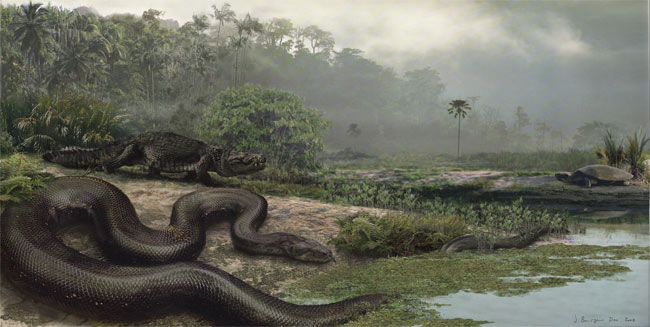Ancient Snake Was As Long As a Bus

A colossal snake about the length of a school bus slithered about South America's rainforests some 60 million years ago, according to an analysis of the skeletal remains of what is now considered the largest snake ever identified.
"It's the biggest snake the world has ever known," said Jason Head, a paleontologist at the University of Toronto Mississauga and part of an international team who discovered and identified the snake bones. He added, "The snake's body was so wide that if it were moving down the hall and decided to come into my office to eat me, it would literally have to squeeze through the door."
Fossils of the extinct snake species, now called Titanoboa cerrejonensis, were discovered in the Cerrejon Coal Mine in northern Colombia. From the fossilized vertebrae, the researchers conservatively estimate the snake weighed about 2,500 pounds (1,140 kg) and measured nearly 43 feet (13 meters) from nose to tail tip.
The giant reptile was a boine snake, a type of non-venomous constrictor that includes anacondas and boas. In the same fossil rainforest, the researchers also found giant sea turtles and crocodile relatives.
In fact, while alive, the snake likely gorged on its crocodilian neighbors. "We think it was a completely aquatic snake, that it didn't really go out on land except to bask every once in a while," Head told LiveScience. "And aquatic snakes generally eat aquatic vertebrates, and the only other aquatic vertebrates around are these primitive crocodiles and these giant turtles. And you can imagine it's probably pretty difficult to eat a turtle when you can't chew."
The snake's enormous dimensions are a sign that temperatures along the equator where the remains were found were once much balmier.
"The bigger you get, the more energy you need overall," Head said. "And since they get their energy from external environments, the bigger they are, the more energy they're going to require from the external environment." (Snakes are cold-blooded animals, so they don't generate their own body heat.)
Sign up for the Live Science daily newsletter now
Get the world’s most fascinating discoveries delivered straight to your inbox.
The researchers calculated that in order to support the slithering giant, its tropical habitat would have needed a temperature of about 86 to 93 degrees Fahrenheit (30 to 34 degrees Celsius).
"Tropical ecosystems of South America were surprisingly different 60 million years ago," said Jonathan Bloch, a vertebrate paleontologist at the University of Florida, Florida Museum of Natural History, who worked with Head on the snake study. "It was a rainforest, like today, but it was even hotter and the cold-blooded reptiles were all substantially larger. The result was, among other things, the largest snakes the world has ever seen ... and hopefully ever will."
The discovery is detailed in the Feb. 5 issue of the journal Nature.
- Snake News, Information and Images
- How Does a Snake Swallow a Larger Snake?
- Top 10 Deadliest Animals
Jeanna Bryner is managing editor of Scientific American. Previously she was editor in chief of Live Science and, prior to that, an editor at Scholastic's Science World magazine. Bryner has an English degree from Salisbury University, a master's degree in biogeochemistry and environmental sciences from the University of Maryland and a graduate science journalism degree from New York University. She has worked as a biologist in Florida, where she monitored wetlands and did field surveys for endangered species, including the gorgeous Florida Scrub Jay. She also received an ocean sciences journalism fellowship from the Woods Hole Oceanographic Institution. She is a firm believer that science is for everyone and that just about everything can be viewed through the lens of science.









